Bob Mayer's Blog, page 2
August 4, 2025
First Time Ever SALE: One In Vermillion

Today through the 7th. One in Vermillion is only .99 or Kindle Unlimited.
Also, Rocky Start is only .99 or Kindle Unlimited on Amazon UK.
Nothing but good times ahead!
Bob
August 1, 2025
Two Things You Must Know About Your Vehicle—One I Just Learned
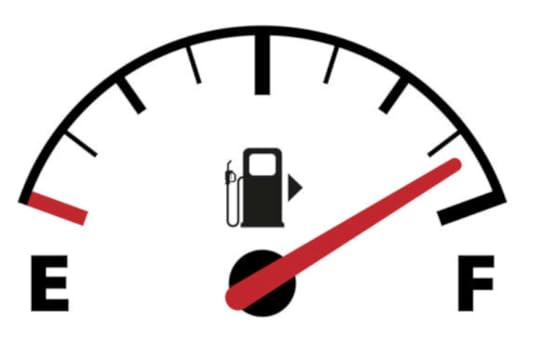
We don’t think of these two things unless something goes wrong. And that’s the worst time to figure them out.
The first is where your spare tire is (if you have one) and where the jack is. You should not only locate the spare, but get it out at least once as it might not be as easy as it appears. For example, on my Gladiator, it’s underneath the truck bed. Seems easy right? Except you have to thread the handle for the jack into a hole between the rear bumper and the truck body in order to lower it. Hard enough on a warm sunny day. Really tough to figure out on a rainy, dark night.
The second is a new one for me as I’ve usually driven standard shift. How do you put your electronic automatic transmission in neutral if your engine is dead? You would need this if you car dies in the middle of traffic and needs to be pushed out of that way or it you need to be towed. You just can’t jam the automatic transmission into neutral. It’s different on almost every model. On my Gladiator and most Jeeps, there’s a small cover in front of the shifter. You pop that and pull the red loop toward the driver’s side. To re-engage, you pull the loop again. On an Audi, it’s very different. There’s a tool with your jack in the back that’s a red handle. You lift the driver’s side floor mat and there’s a little door there. Lift it. Push the tool in. Turn 90 degrees and you unlock the transmission. So, go look this up for the year and model vehicle you drive now, before you’re the one blocking traffic and no one can get your car out of the way!
And, bonus, third, if you’re driving someone else’s car, or a rental, to know which side the gas cap is on, look at the fuel gauge and there’s a small arrow pointing to that side.
I’ve got two of these in Life’s Little Black Book and I will be adding the third to the next edition.
BTW, The New York City Little Black Book has been getting a lot of attention lately.
Turn it up to eleven, people!
July 31, 2025
BUILDING A BUNKER? THE INVERSE RULE OF SURVIVAL SECURITY
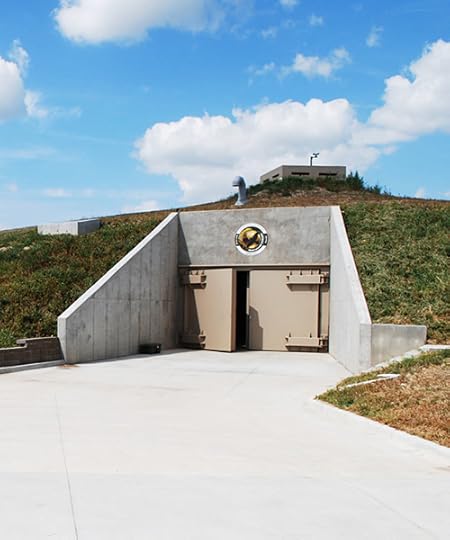
When I consult with clients about the Area Study and preparation for disastrous events, I often run into those who favor a fixed position for their Bug Out Hide Site. In fact, there are people who’ve poured millions of dollars into such a place.
There are many advantages to a fixed location.
There are also disadvantages.
One of those is the inverse rule of security. A fixed position is a known target. I often joke that the poor man’s survival guide is to find you nearest heavy prepper with a fixed site and take it. I get pushback from those people almost daring people to try it.
Then I have to walk them through how they are actually going to secure that site. One person cannot pull 24 hour security, seven days a week. You need more people. Every person you add, increases the security but also increases the threat.
Backing up from that, what about the people who built and stocked the fixed site? Unless one acts like an ancient Pharaoh and buries them inside (aka what I did in Area 51: Earth Abides) they know where it is. The locals know where it is. I have never deployed to any place in the world, even over a hundred miles from the nearest town, where the locals didn’t know we were there, no matter how covert we were trying to be. This applies to those who do it themselves on their own property. Your neighbors, no matter how distant, know you’re there and they have a good idea what you’re doing. I’m sure there are those who’ve gone so remote, they are hidden. Kudos to them. On the opposite end of that spectrum are the advertisements for multi-million dollar survival condos inside renovated missile silos. Nothing like advertising one’s location and I covered this scenario in Area 51: Invasion.
As a writer of both fiction and nonfiction, I have learned to improve each side by dipping my brain into the other. I had to think through a survival silo in writing those scenes in Invasion. At the same time, it caused me to update material in my Green Beret Preparation and Survival Guide.
So, you’re going to need guards. There was an image of the security detail, publicly posted, for one of those silos. The first thing I noted was that their weapons take different calibers of ammunition, which by itself, rings a warning bell. I have no idea what the qualifications of these people are as far as security.
Also, the article which interviewed the owner, said the location was “Top Secret” but somewhere north of Wichita. First, the locals know where the missile silos were. Second, I was able to find the location with a two-minute Google search. First result said two hours north in the Concordia area. A second search using that not only got me location but numerous pictures of the area. I’m not saying this is a totally bad idea. In fact, it has a lot going for it. Depending on the SHTF scenario. Which every survival scenario always comes down to– there are an infinite number of variables. That’s why I beat to death doing the personal Area Study to prepare for the most likely, from mild to most extreme. A survival silo condo is part of the possible solutions but should not be the only one.
I start with basic security of a patrol base, Ranger-handbook style. One key of that security is you know you can count on the other people in your unit to do their job and not turn on you. Not so in a SHTF scenario. In fact, if a situation becomes so extreme one must bug out to the fixed site, normal leverage, such as money, no longer is as important. Just because you built and funded the place doesn’t mean you maintain leadership when those two factors no longer count.
How will you maintain loyalty? Ultimately, the way is by building a ‘family’ that will bond together. Surprisingly, when I bring this up, the richer they are, the more negative the reaction.
Like many things in preparation and survival, it is an aspect few have thought through. Have you?
The Green Beret Preparation and Survival Guide. Also in Kindle Unlimited.
July 30, 2025
YOUR SURVIVAL A-TEAM
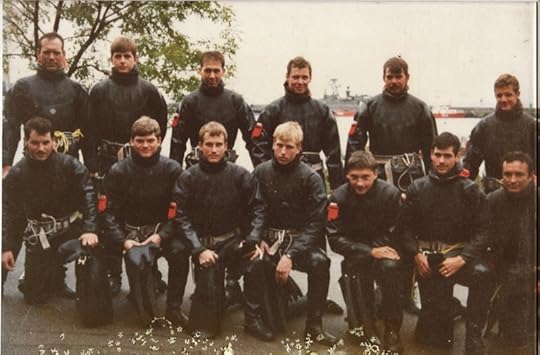
For many of us, a ‘team’ is a no-brainer’. Our family is our survival team. For others, though, this is a decision: whether to try to make it on their own or join forces with others. There are advantages and disadvantages to a team, which also change depending on whether you have a mild, moderate or extreme emergency. Here are some for you to consider:
Advantages
The whole is greater than the sum of its parts. You can’t be an expert on everything. Having an array of people who bring different, needed skills, is important. Some people just can’t handle being alone. Can you? Have you ever spent a night out in nature alone?
A sense of purpose. In combat, soldiers fight for each other, not for a cause. Being a member of a team can increase your motivation to get out of yourself and fight for the survival of those who you care about.
In an extreme emergency, long term survival will eventually depend on team building. In this scenario you often won’t have much of a choice who you will ally with. Groups will form with different agendas. You have to evaluate your goals, and also whether you will be an asset to the team. What do you bring to the table?
Disadvantages
You make a larger target. It is indeed better to run away rather than fight. Your running away is limited by the slowest member. The only soldier I had to remove my A-Team couldn’t keep up with us in the field, carrying our extremely heavy combat load. You are also more likely to be discovered in an extreme survival situation as part of a team.
You are letting others in on your survival plan. The lazy survivalist simply lets others prepare, then comes in and plunders.
I’ve consulted with wealthy clients and always have to bring up my inverse rule of security: the more people you bring in to provide security, in an extreme situation where money will no longer be a factor, the more dangerous you have made your situation.
Will the other members of the team be prepared? If it’s your family, it’s your responsibility to get them ready since you’re reading this.
Will the members of the team actually pull their weight? To wait until a survival situation to evaluate team-members is foolhardy. The more people on the team, the more security gets looser. I call it the trust ripple effect. How many people do you trust? Trust with your life? How many people do they trust? In the move Contagion, as soon as the CDC character tells his wife about the outbreak and to get out of town, warning her to ‘TELL NO ONE’, what does she immediately do? Tell someone. As Ben Franklin said: “Three may keep a secret, if two of them are dead.” In covert operations we tended to be very paranoid, but you’re not paranoid if they are out to get you.
Where to find survival A-Team members?
Most likely it will be your family.
Think about last Thanksgiving. Do you really want to huddle in a BOHS with those people?
Joking.
Not.
In mild to moderate emergencies, you will want to gather your family and team members as quickly as possible.
Other places to find potential survival buddies:
Your friends.
From your job. Actually, you should quietly evaluate your co-workers anyway, because the percentage of time you spend at work is the percentage chance an emergency or natural disaster will strike while you are among them. On Nine-Eleven certain co-workers proved to be true life-savers.
Your church
Hunting and garden clubs. Two extremes here, but each brings something to the table.
Those attending self-defense classes or survival workshops. Hiking clubs.
Who Do You Want On your A-Team?
Often this won’t be a choice. You’re going with your family/loved ones.
However there are those who want to build a team and/or train their family members/loved ones in the necessary skills for a survival team.
Using the A-Team above, let’s discuss who you’d want to have on your team and what skills they should have before an emergency. These are also the choices you might have to make while in or after an extreme emergency/catastrophe.
The first person many think of is someone who is ex-military. I even point out that you’d most likely want a Green Beret as your #1 choice, but remember, those are Special Forces; not your run of the mill military person. The majority of veterans, while they have some basic training, were support personnel, so you have to consider what their MOS- military occupation specialty was.
Then there is the ‘prepper’. Unfortunately, too many people confuse owning a bunch of guns and stockpiling ammunition and food as ‘preparing’. As you can see from this manual, I give little mention to this topic. First, if firing guns comes into play, you are in, or just escalated into, an extreme emergency. The odds of a mild or moderate emergency are much, much higher and need to be prepared for first.
Simply owning guns doesn’t mean a person knows how to use them. Even hunters who use long guns may be great shots, but there’s a big difference when we’re talking Close Quarters Battle.
The other issue with guns is you can only carry a couple. Unless you’re a “shooter”, someone whose full time job is training on weapons, you can only be proficient on a couple of guns. It’s better to have two you know how to use than 40 sitting in your gun locker.
So who do you want?
The most important attribute is someone who handles crisis well. Who doesn’t panic. Unless you’ve actually seen someone in an emergency, this is a hard quality to ascertain.
Focus on skill sets:
Medical
Law enforcement and military
Leadership
Survival
Communications
Engineering
Weapons (both close quarters battle and hunting)
Gardening, farming
Ranching
Electrical
Scavenging. This last one is a skill one rarely thinks of. But as we will see in Survival, a key phase after a moderate to extreme emergency is scavenging. Not just scavenging (being able to find things), but also the ability to improvise. A MacGyver type of person, who can make something out of disparate parts. Who can find different uses for things. Interestingly, often woman are better at this than men because men tend to be linear thinkers. For a man the only way to get to B is from A. Women tend to be circular thinkers and they might think the best way to get to B from A, is to go to C and loop back. And often, it is.
July 29, 2025
What Books Should You Have In Your Survival Library
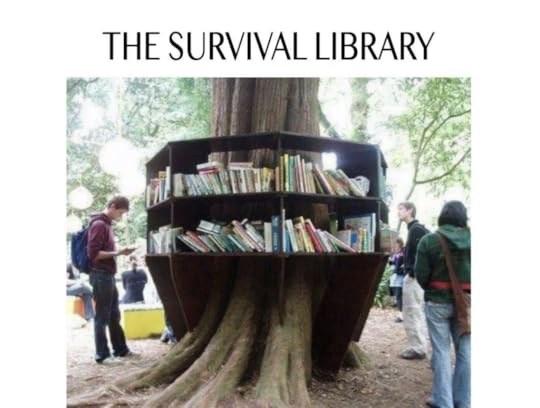
When discussing preparation, a key element that is overlooked is knowledge. Knowledge is invaluable. We simply can’t be experts on everything from first aid to farming to animal husbandry to metal working. Others can help show the way. A sustainment library should be both electronic and physical. An electronic library can be sustained given solar power and power packs. A physical library lasts even longer. But both must be protected from the elements.
Electronic versions must be downloaded on the devices you will use before a disaster. I keep mine on my laptop, my iPad, and my iPhone.
Here are some books I recommend in addition to my own Green Beret Preparation and Survival Guide that I have downloaded and on my shelves and ready to be grabbed in case of evacuation or bugging out.
Survival and Sustainment Library:
When Technology Fails: A Manual for Self-Reliance, Sustainability and Surviving the Long Emergency by Matthew Stein. A great resource of information for long term skills.
SAS Survival Handbook by John Wiseman. Redundant to some information in this book, I have it because of the images of plants and other matter.
The Green Beret Area Study Workbook. Walks you through evaluating your Area of Operations for threats and assets.
Peterson Field Guides put out a series of books about plants. Two keys are:
Field Guide to Medicinal Plants and Herbs of Eastern and Central North America
Unfortunately those two books aren’t available in eBook and having a plant guide on your cell phone you can easily bring up is very useful. I have:
Wild Edibles: A Practical Guide to Foraging, with Easy Identification of 60 Edible Plants and 67 Recipes by Sergei Boutenko
Basic Fishing: A Beginner’s Guide by Wade Bourne is very useful. Remember, that the Donner Party never even attempted to fish in the nearby lake, even though it had trout in it.
The Gift of Fear: And Other Survival Signs That Protect Us From Violence by Gavin de Becker is a classic that applies to more than just survival situations.
My Side of the Mountain by Jean Craighead George is a classic story of survival that is great to read with your kids to introduce them to survival situations and information.
The Ultimate Survival Medicine Guide by Amy Alton. This is the premier book for survival medicine when a doctor or hospital is not available.
The Green Beret Preparation and Survival Guide by Bob Mayer. Duplicates a lot of the SAS manual, but has more on preparing.
The Green Beret Area Study Workbook by Bob Mayer. This will allow you to focus your preparation for yourself and your specific situation saving you time and money.
July 28, 2025
How to Prevent Getting Lost

We can get lost in a variety of ways. I work under Daniel Boone’s precept: “I’ve never been lost, but I will admit to being confused for several weeks.”
While I’ve done a lot of land navigation, both day and night, and spent considerable time working off of maps during training and on deployments, there have been times when I’ve gotten ‘confused’. My experience is that once I got lost, it could easily escalate into something worse, unless I follow some guidelines.
As with all aspects of preparation and survival there are numerous variables. We should be properly prepared before any trip with the correct supplies to keep from getting lost such as GPS with applicable map tiles loaded, paper map backups (including in your car), a compass, signal mirror, whistle, signal panel and more.
Know how to use a map and compass. Remember, a compass can’t tell you which way to go if you don’t have an idea where you are. Your local REI stores runs courses on basic land navigation. There is no substitute for actually getting out there and actually doing it.
A big key is if off road is to know what is your ‘safe’ direction. That’s the direction where you will eventually hit a known line, whether a road, rail-line, river, etcetera which will let you know where you are. Then you also need to know whether to turn left or right on that limit to get to safety.
Have enough food and water for whatever activity you plan, plus a bit extra.
Always have a paper map and compass. You can lose your GPS/phone or the battery might die.
[image error]SHORTS CUT ARE RARELY EVER SHORT
AND CAN BE DEADLY
Let someone know where you’re going. What your plan is. When you expect to be back. An important key is to tell them after what time, without hearing from you, they should notify help. I do this even if just heading out for a bike ride or run. I use Road ID when I go for hikes/bikes/runs where there is cell phone coverage. I check in with my SPOTX when going on longer or overnight trips. If I change plans for any reason, I update my contacts for both.
At a trailhead it pays to leave a note inside your car/truck window, facing out, with information on what your plans on. When you expect to be back. I’ve checked trucks and cars at trailheads and most are unmarked. I know there might be a fear that someone would break in to the car, but weigh that against not making it back?
Fill out wilderness permits and check in at Ranger Stations. Make yourself noticeable. A couple was left behind on a scuba trip because they kept to themselves, didn’t interact with others and no one missed them on the trip back.
I cover what to do if you do get lost in the Survival section of the book.
What To Do If You Get Lost
Should you stay or should you go?
For most situations, it’s best to stay in place.
If you are injured. Don’t exacerbate your injury by moving.
Search and Rescue will start at the last known place you were or where they think you are. Moving could take you out of the likeliest search area. If you’re lost and don’t have a plan, you will get more lost.
[image error]LOOK BEHIND YOU WHEN
TRAVELING SO YOU KNOW
THE ROUTE BACK
Search and Rescue is usually free. The reason for that is often these teams are made up of volunteers. More importantly, they don’t want people to hesitate to call. When in doubt, Call 911 because most teams work through the local sheriff’s office. Remember, a text has a better chance getting through than voice if your signal is shaky. Conserve your phone’s battery as much as possible. If you make contact, set up a time to check in so you can turn the phone off in between.
The key rule to follow is STOP:
STOP: As soon as you suspect you are lost immediately STOP. Many people panic and while in that panic make the situation worse. Panic is your greatest threat.
THINK: How did you get here? What landmarks do you remember? Which way did you turn if you left an established trail? What direction? Do not move until you have a specific reason.
OBSERVE: Which direction is north? Do you have boundaries such as a river, mountain range, road, etcetera that you know for certain are in a certain direction?
If you are on a trail or road stay on it. Roads and trails are built to take advantage of the easiest route. While you might think taking a “shortcut” cross-country might save time and distance, it won’t.
As a last resort, follow drainage downhill. Streams run into rivers and there is usually civilization along rivers. However, depending on terrain, this might not be possible. Also, try not to get wet, especially if the temperature will drop, as hypothermia is deadly.
Can you follow your own trail back to the last known spot? Footprints? Broken branches?
PLAN:
Before moving make sure you have a plan. Think the plan through. Are there other options?
If you are not confident in your plan, stay in place.
Don’t move at night. When we were heading toward the Grand Canyon, my wife said she thought people probably fell into it. When we got there, I saw she was right. Anyone who has been on patrol at night can tell stories of the cat eyes on the back of the cap of the patrol member right in front disappearing as they fell off a ledge or cliff.
[image error]STOP: As soon as you suspect you are lost immediately STOP.
Many people panic and make the situation worse.
THINK: How did you get here? What landmarks do you remember?
Do not move until you have a specific reason.
OBSERVE: Get oriented. Which direction is north?
If you are on a trail or road stay on it.
Roads and trails are built to take advantage of the easiest route.
PLAN: Before moving make sure you have a plan.
Think the plan through. Are there other options?
If you are not confident in your plan, stay in place.
Signal for help: Cell phone. Satellite messenger. Mirror or anything reflective.
The universal distress signal comes in threes: three blasts on a whistle.
Make a smoky fire. Green leaves and grass help. Rubber makes black smoke. The flame at night is a signal. A VS-17 or bright clothing can be used to signal.
To aim a mirror, hold it in the palm of your hand. Extend the other hand with two fingers forming a V in the direction you want to signal. Angle the mirror so that the reflected light passes through the V.
If you must self-rescue:
Rest when you feel tired. Don’t push it too hard so that you become exhausted.
You can’t hike and easily digest food at the same time. Eat and then rest.
Stay hydrated.
Mark your trail as you move, so at the very least, if need be, you can get back to where you started.
WHAT TO TEACH CHILDREN TO DO IF THEY GET LOST:
Make sure your child knows both parent’s full name, phone number and address. Memorizing key phone numbers is a skill all of us need to practice.
Have your child practice calling your phone.
Teach your child how to ask for help. While we emphasize ‘never talk to strangers’ tell them who it is best to ask: police, a mother with a child, a store salesperson with a name tag, a security guard.
Tell them not to go looking for you if they become detached. It is best they stay in place and you find them.
Excerpted from The Green Beret Preparation and Survival Guide
July 27, 2025
Stop Thinking Someone’s Going To Rescue You

I wrote this post after there was a snowstorm on the east coast and thousands of drivers were trapped in freezing temperatures on I-95 in Virginia. A number of circumstances collided to produce this; one of them being a lack of plow drivers and emergency personnel due to record Covid numbers.
How many of those trapped drivers took to the road unprepared for an emergency? Most. How many have a good pair of walking boots in their vehicles? Few. How many have blankets and extra water and food? Few. How many failed to check the weather?
We have a “normal” mentality. What I mean is we expect things to be normal, then get surprised when they aren’t. Worse, when things are abnormal, we expect someone to come rescue us rather than prepare to take care of ourselves.
When hurricanes or tornadoes or floods strike, help comes pouring in from unaffected nearby communities and states to help. But what if there is a disaster so large, that help isn’t available? Can you help yourself? What if, like today, a convergence of events: storms, accidents, COVID, come together to produce an unprecedented disaster?
Even a light perusal of recent news show disaster after disaster. Killer tornadoes. Winter storm. Drought. Floods. Devastating wildfires. It’s not going to get better.
So why don’t people prepare?
Complacency.
The assumption that help is only a cell phone call away.
A lack of focus.
Mainly, a mindset of “it can’t happen to me.”
Except 1 in 3 Americans experienced a climate related disaster in 2021.
We will see more extreme weather of all types.
Emergency services will continue to be stretched to the limits.
Bottom line? Get prepared. Take it step by step but start today. Tomorrow might be too late.
From page 1, you will be better prepared: The Green Beret Preparation and Survival Guide
Good luck and be safe!
July 26, 2025
Hot Weather Preparation and Survival
Hot Weather Preparation and Survival
Heat can kill directly via heatstroke. It can also increase your chances of succumbing to a heart condition, stroke or other breathing problems. Hundreds in the US die each year during heat waves. It is estimated that number will only grow higher as temperatures continue, on average, to increase.
Your body wants to maintain a steady core temperature of 98.6 F. When you begin to heat up, your nervous system diverts blood away from your internal organs and to your skin to radiate heat away. Sweat glands release water, which has a cooling effect as it evaporates from your skin.
The best preparation to prevent heat injuries and death is to stay cool. Get out of the sun. Don’t over-exert yourself.
Keep air-conditioning at a livable level. However, if there is a power outage or you don’t have air-conditioning, there are things to keep in mind: Lower floors are always cooler as heat rises. Close shades and lower blinds. Go somewhere that does have air conditioning such as a mall, shelter or theater.
Use fans in your house to promote circulation of air. In the evening and at night, open windows to let in cooler air, then close them in the morning along with blinds and shades. Turn off extra sources of heat such as lights and appliances. Don’t use the stove or oven.
Eat lighter meals during a heat wave so the body doesn’t have work as hard digesting, producing more internal heat. Keep your skin covered. If outdoors, wear a hat to protect from sunlight. Wear lighter colors to reflect sunlight. Avoid alcohol and caffeine as they are diuretics and dehydrate you.
Remember your pets. They also suffer in a heat wave. Put them in the shower. Give them a cool, wet towel to lie on. Make sure they have plenty of water to drink.
Over three-quarters of your body is composed of fluid. Perspiration is not the only way you lose water. We actually lose more water just by breathing. And you can’t stop that loss. We lose around 2 to 4 cups of water a day by exhaling (16 cups equal one gallon). We lose about 2 cups via perspiration. We lose one half to a full cup just from the soles of our feet. We lose six cups via urination. You lose a more than half a gallon of water a day just existing; more depending on the weather and your activity level.
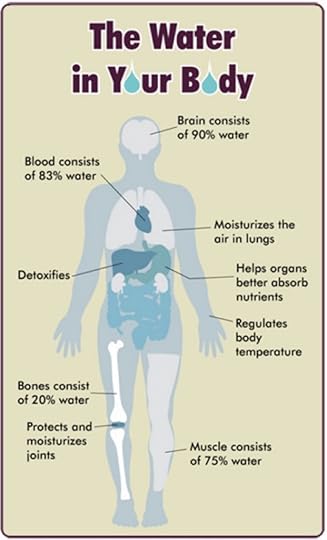
Dehydration results from inadequate replacement of lost body fluids. It decreases your efficiency and, if injured, increases your susceptibility to shock.
Symptoms of dehydration are: Dark urine with a very strong odor. Low urine output. Dark, sunken eyes. Fatigue and Emotional instability. Delayed capillary refill in fingernail beds. Trench line down center of tongue. Thirst. Last on the list because you are already 2 percent dehydrated by the time you crave fluids.
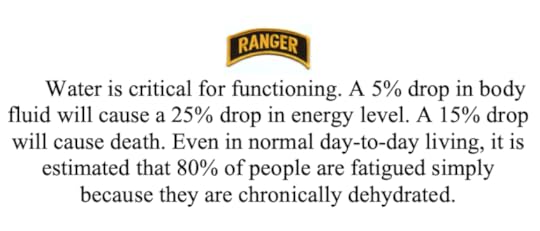
Treatment: Replace the water as you lose it. Trying to make up a deficit is difficult in an emergency situation, and thirst is not a sign of how much water you need. Most people cannot comfortably drink more than 1 liter of water at a time. Nor do you want to. So, even when not thirsty, drink small amounts of water at regular intervals each hour to prevent dehydration.
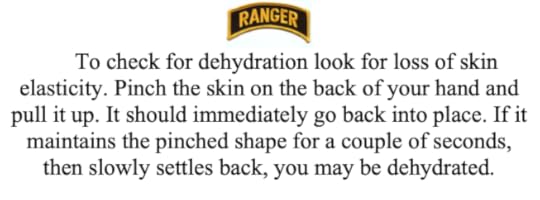
Drink sufficient water but don’t overdo it. Over- hydration is a potentially fatal condition. You drink too much water for your kidneys to process. It’s not just the amount, but how quickly you drink the water. Drinking too much water increases the amount of water in your blood. This dilutes the electrolytes, especially sodium. Sodium is critical in balancing the fluid inside and outside of cells. When there is an imbalance from over-hydration, sodium moves inside the cells, causing them to swell. This is particularly dangerous to your brain cells.
Thus, one of the first symptoms of over- hydration is a headache. Nausea and vomiting are also symptoms. If it gets worse, more symptoms follow, including high blood pressure, confusion, double vision, drowsiness, difficulty breathing, muscle weakness and cramping. If not caught in time, seizures will occur, brain damage, coma and even death
If you are under physical and mental stress or subject to severe conditions, increase your water intake. Drink enough liquids to maintain a urine output of at least half a quart every 24 hours.
For dehydration that is short of heat stroke: Drink two quarts of water, juice or sports drinks in 2 to 4 hours, not all at once. Small sips every few minutes work best. If vomiting, try ice chips, popsicles and small sips. If also suffering from diarrhea, stay away from using sports drinks as the sugar can make it worse.
The breakdown of the body’s heat regulatory system causes a heat stroke. It occurs when your core body temperature goes to 104 degrees. Other heat injuries, such as cramps or dehydration, do not always precede a heatstroke. Heat stroke is extremely dangerous. As with all other dangerous conditions, call 911, evacuate or get profession help if possible.
Heat Stroke Symptoms: Swollen, beet-red face. Reddened whites of eyes. Victim not sweating. Red, hot and dry skin. Unconsciousness or delirium, which can cause pallor, a bluish color to lips and nail beds (cyanosis), and cool skin.
Heat Stroke Treatment: Fan air over the victim while wetting skin with water. Apply ice packs to the armpits, groin, neck, and back. These areas have more blood vessels on average, so cooling them can reduce the body temperature. Immerse the patient in a shower or tub of cool water. Or a stream or lake. Be sure to wet the victim’s head.
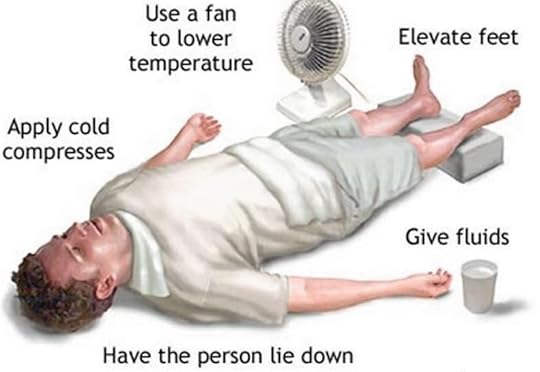
Expect, during cooling: Vomiting. Diarrhea. Struggling. Shivering. Shouting. Prolonged unconsciousness. Rebound heatstroke within 48 hours. Cardiac arrest; be ready to perform CPR. Bottom line: Get to an ER or doctor ASAP! Hot Weather Preparation and Survival
STAY COOL!
FREE, downloadable slideshows on survival, writing, history and other matters. HERE.
July 25, 2025
Prepare for and deal with Flash Floods
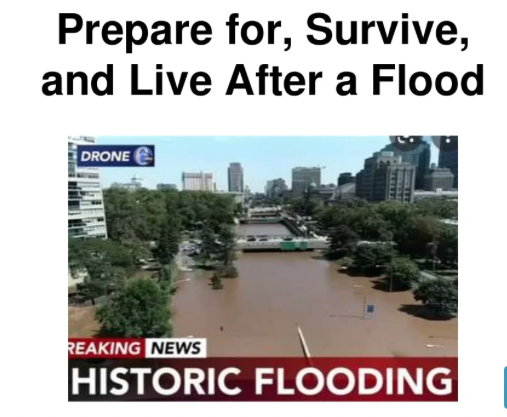
Someone on twitter asked me about this, referencing several recent disasters, where people experienced flash floods. So here goes.
Flash floods are sudden and powerful natural disasters that can occur with little to no warning. They pose a significant risk to life and property, making it crucial for individuals and communities to be prepared. By taking proactive steps and having a solid emergency plan in place, you can enhance your safety and minimize the potential damage caused by flash floods. This blog will provide you with a detailed guide on how to prepare for flash floods, empowering you to protect yourself and your loved ones.
1. Understand Flash Floods:
To effectively prepare for flash floods, it’s important to understand what they are and how they occur. Flash floods are rapid-onset floods caused by heavy rainfall, dam or levee failures, or sudden snowmelt. They often happen in low-lying areas, near rivers, and in urban environments with poor drainage systems. Recognizing the signs and knowing the flood-prone areas in your vicinity will help you make informed decisions and take immediate action when necessary. However, a lot depends on the composition of the ground under you. Our house in Boulder, Colorado, on top of a ridgeline, flooded after a torrential flash rain and the entire water table rose up and flooded everyone’s basement. So be aware of drainage!
2. Stay Informed:
Keeping yourself updated with weather forecasts and flood warnings is vital. Utilize local news sources, weather apps, and official websites to stay informed about potential flood risks. Sign up for emergency alerts or notification systems provided by your local government or disaster management agencies. This will enable you to receive timely information, evacuation orders, and safety instructions.
3. Create an Emergency Plan:
Developing a comprehensive emergency plan is essential for every household. Discuss the plan with your family members or roommates to ensure everyone understands their roles and responsibilities. The plan should include:
a. Evacuation Routes: Identify the safest evacuation routes from your home or workplace to higher ground. Be aware of alternate routes in case the primary ones are inaccessible.
b. Emergency Meeting Points: Establish designated meeting points both within your neighborhood and outside, in case family members are separated during the evacuation. I cover the IRP, ERP and Big Out Hide Site (BOHS) in detail in The Green Beret Preparation and Survival Guide. In fact, everything below is covered in detail there, but this is an overview.
c. Communication Strategy: Determine a reliable communication method to stay in touch with your loved ones during emergencies. Share contact information with each other and have backup power sources for mobile devices.
d. Emergency Kit: Prepare a well-stocked emergency kit that includes essential items such as non-perishable food, water, medication, flashlights, batteries, a first aid kit, extra clothing, blankets, and a battery-powered radio.
4. Safeguard Your Property:
Taking preemptive measures to protect your property can significantly reduce flood-related damage. Consider the following steps:
a. Elevate Essential Utilities: Raise electrical panels, switches, sockets, and wiring systems above the flood level. Similarly, elevate HVAC equipment, water heaters, and other appliances.
b. Install Check Valves: Fit check valves in sewer traps and drainpipes to prevent floodwater from backing up into your home.
c. Waterproof Basements: Apply waterproofing sealants to basement walls and floors. Consider using flood-resistant materials and keep valuable items elevated or stored in waterproof containers.
d. Clear Gutters and Drains: Regularly clean and maintain gutters, downspouts, and drains to ensure proper water flow. This will prevent clogging and minimize the risk of localized flooding. One item I highly recommend getting that can save your life and/or save you a lot of damage from accidental floods is a water alarm. Here’s a post I did on that after the deadly floods in Kentucky in 2022. Here is the direct link to a battery powered alarm on Amazon—definitely worth $12.50.
5. Insurance Coverage:
Review your insurance policy, especially the coverage for flood damage. Standard homeowner’s insurance typically does not cover flood-related losses, so it is crucial to consider purchasing flood insurance separately. Consult with your insurance provider to understand the options available and ensure adequate coverage for your property.
6. Practice Flood Safety:
During a flash flood, personal safety should be your top priority. Remember the following safety guidelines:
a. Evacuation: If authorities issue an evacuation order, follow it immediately. Do not attempt to cross flooded areas by foot or in a vehicle.
b. Avoid Low-Lying Areas: Stay away from creeks, streams, and drainage channels, as they can quickly fill with fast-flowing water.
c. Turn Off Utilities: Before leaving your home, turn off gas, electricity, and water supplies to prevent hazards or further damage.
d. Seek Higher Ground: Move to higher elevations and find sturdy shelter in a multi-story building or on a roof if necessary. Never seek refuge in a flooded attic or basement.
e. Do Not Drive Through Floodwater: Avoid driving through flooded roads, bridges, or underpasses. The depth and strength of the water may be deceptive, and you risk being swept away. I cover what to do if you get swept away in your car in the books and elsewhere.
Conclusion:
Preparing for flash floods is crucial to safeguard yourself, your family, and your property from the devastating impacts of these sudden disasters. By understanding the risks, staying informed, creating an emergency plan, protecting your property, and practicing flood safety measures, you can be better prepared to respond effectively and mitigate potential damage. Remember, preparedness is the key to resilience, and it can make a significant difference in your safety and well-being during flash flood events.
What specific disaster, perhaps unique to where you live, would you like to see me cover?
July 24, 2025
First Five Things To Do In An Emergency
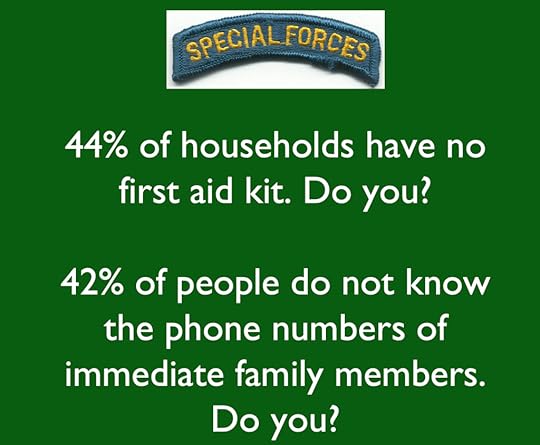 Every situation is different and this is a guideline. Always make sure your priority is safety for yourself first, then others. You can’t help others if you don’t take care of yourself.
Every situation is different and this is a guideline. Always make sure your priority is safety for yourself first, then others. You can’t help others if you don’t take care of yourself.First:
Do a First Aid triage of yourself. Breathing. Bleeding. Broken.
Are you stabilized?
Can you move?
Assess the immediate situation. Take charge.
If in immediate danger, get to a safe place. If you’re not in immediate danger, look around.
What are the priorities of threats? Other people will be panicking. Don’t get caught up in that. Be aware that any situation can get worse. In fact, assume it will. Also, having done your Area Study, you know there are after-effects of various emergencies and natural disaster. Earthquakes around the coast can lead to tsunamis. A terrorist attack could have a follow on attack for first responders. A hurricane can lead to broken gas lines which lead to a fire danger.
Check for smoke, gases and fumes. Locate and shut off the source if possible. Fires, earthquakes, bombs, etc. produce structural instability. Just because the roof is still there, doesn’t mean it will stay there.
If in a car accident, turn off ignition, look out for pools of gas or any smoke.
Second:
Call for help. Dial 911. Yell. Blow a whistle. Tap on a pipe with a piece of metal. Whatever is appropriate to the event. If you’re performing CPR, yell at someone nearby to call for help. Tell them what to say.
Getting trained personnel on the scene quickly is the best assistance you can render others. If you talk to a dispatcher, give a succinct summary of the situation: Location; what the emergency is; how many casualties and an estimate of condition; any potential threats.
If it is a mass casualty event, let them know that right away as the response will be different as a single responding unit would be overwhelmed.
Third:
Do a First Aid Triage of others. Triage comes from the French word ‘to sort’. The goal is to rapidly assess and prioritize a number of injured individuals and do the most good for the most people. The key here is it is not to do the best for every individual.
First, make sure the injured are not in imminent danger.
How many are injured? How badly?
Who can assist you?
Can assistance get to you?
Can the wounded by moved if they have to be? Do you have the means to move them?
If immediate help is on the way, don’t take any unnecessary risks. Don’t move an injured person unless they are in immediate danger. Don’t treat past life-saving measures. Let the professionals do their job when they arrive. Your job is to maintain until help arrives.
What is the status of your A-Team? If some members aren’t present, where are they? Can you communicate with them and arrange to meet? If you can’t communicate with them, can you contact your out of area emergency contact? If that’s not possible the priority of meeting locations will be in order: home, IRP, ERP, BOHS.
Fourth:
Assess the environment. Can you stay or do you need to leave? Do you have adequate shelter where you are for the environment? If you’re staying, at home, at the IRP, ERP, work, school, wherever, inventory your supplies and gather what you can. Focus on water, communication, food and medical.
If leaving and you have time, dress in your emergency clothing. Take your Grab-n-Go bag (home, car or work/school). If leaving, are you going to the IRP to meet A-Team? Or is it best to go direct to the ERP?
If you’re leaving and not going to any of those, what is your destination? Can you get hold of your out of area emergency contact? Are they clear of the effect of the emergency or disaster? The destination should be chosen by priority among shelter, water, food, and medication.
Fifth:
Once in a safe place, assess the overall situation and make long term plans.



